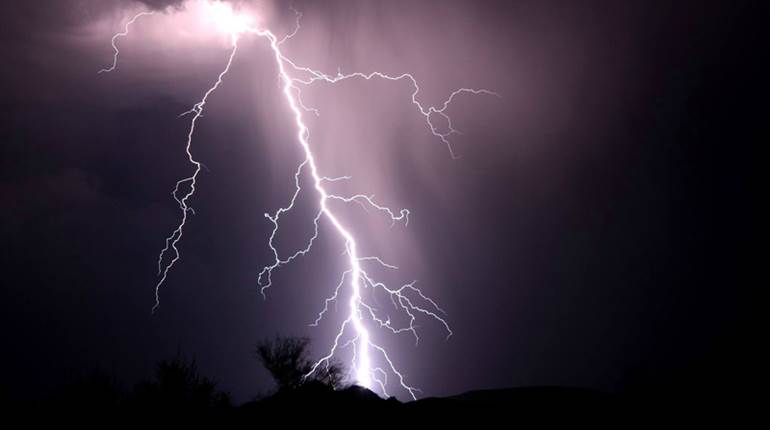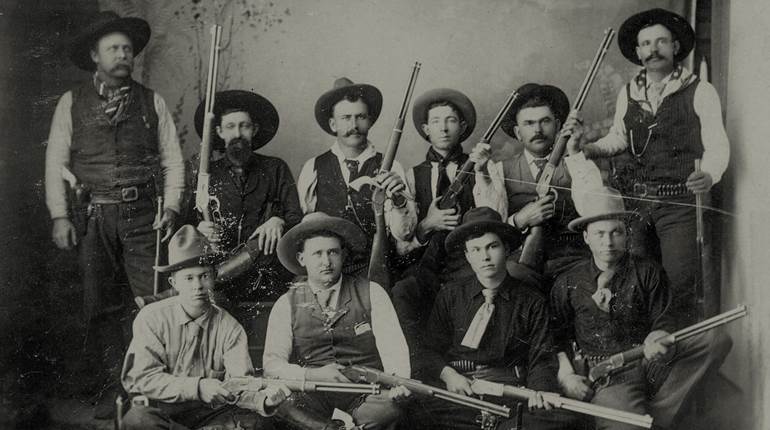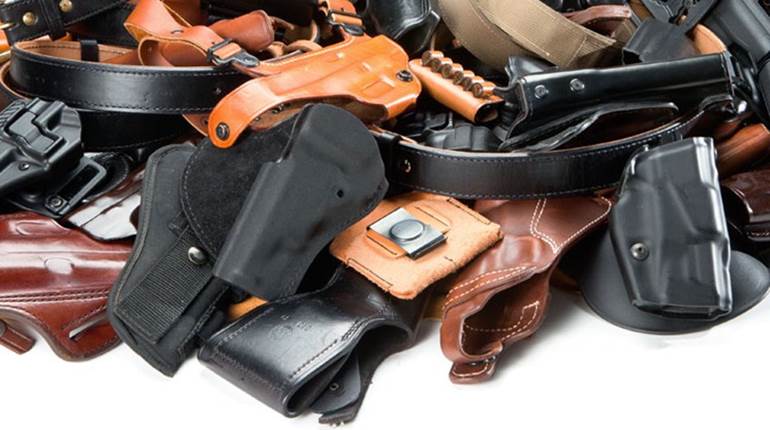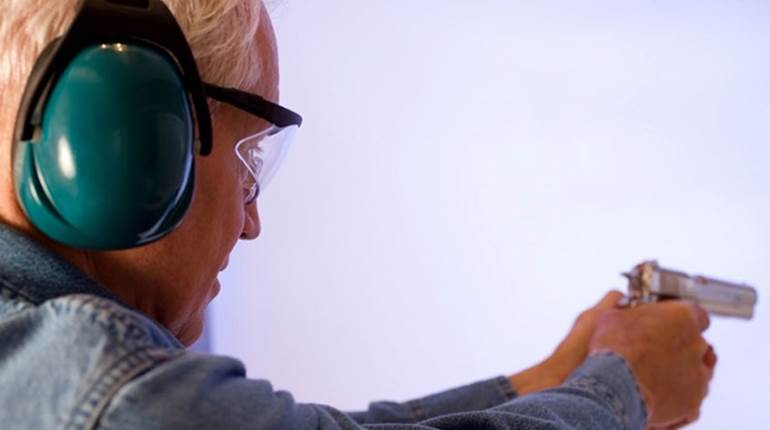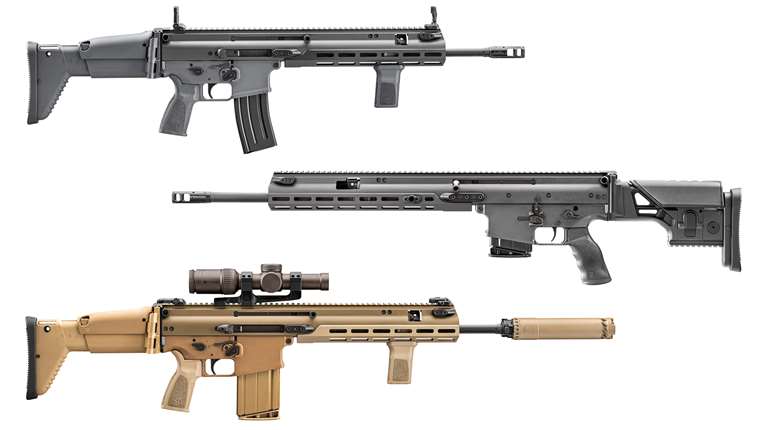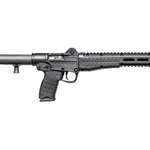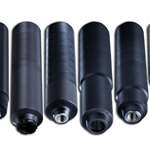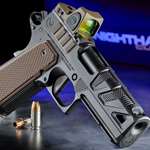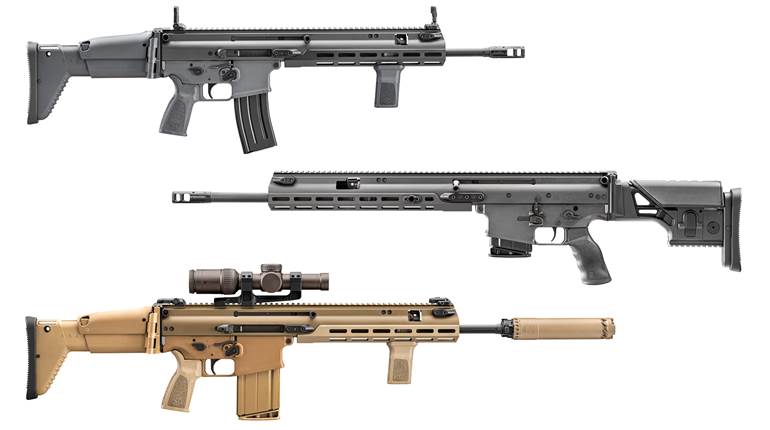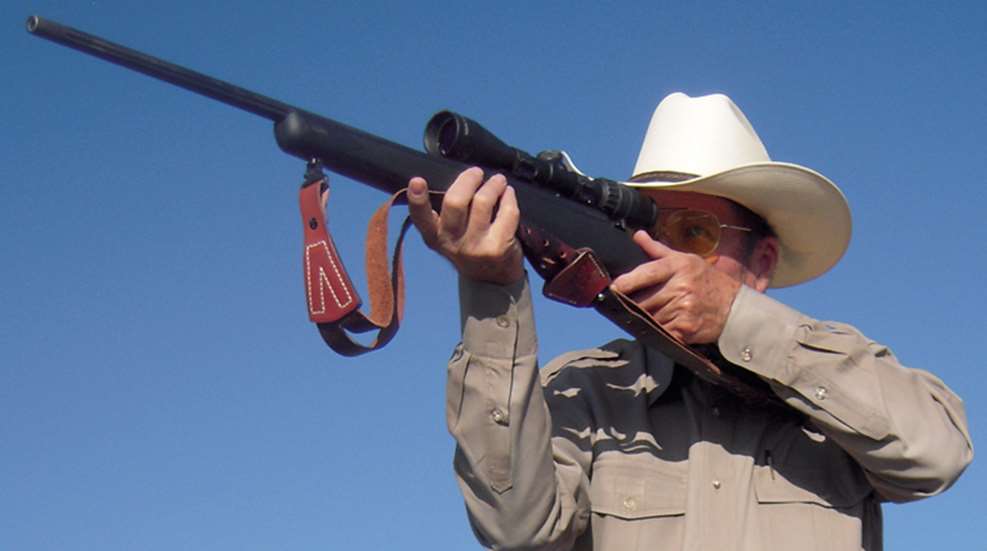
The goal of every ethical hunter is to make clean, humane kills on his chosen game animal. In order to deliver consistently accurate shots, the hunter must have a solid foundation from which to launch his bullet. And that solid foundation is the hunter’s own body. This is the reason that it is so important to develop and practice good shooting positions.
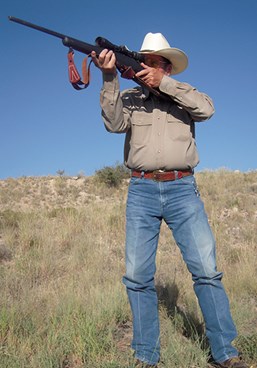 STANDING:
STANDING:
The farther we are from the ground the less steady we are, and that is why the standing position is a tough one for the rifleman. Regardless, there are times, such as still hunting whitetail deer in heavy cover, when shooting from the standing position is about the only option.
Under these circumstances, the best stance is to be squared toward the target as opposed to the bladed stance of the rifle marksman. The feet are planted about shoulder-width apart, with the strong-side foot leading just a bit, usually only a few inches. The knees are bent ever so slightly, and the weight of the body is on the balls of the feet. As the rifle is brought into the shoulder pocket, both elbows are turned down.
To some this might appear very similar to the defensive technique of the rifle as taught by many of today’s instructors. They would be correct. The advantages of this technique are that it allows the shooter to absorb the rifle’s recoil much more effectively, to run the bolt and get back on target quickly. It also places the shooter in a more aggressive stance that allows him to move, in just about any direction, as his target requires. This can be useful when trying to get a shot at a meandering whitetail buck, and it can be critical when trying to sort a Cape buffalo out of the tall, uncut grass.
Delivering precision hits on game animals when firing from the standing position is relatively difficult. Therefore, the shooter should be continually conscious of nearby, available tree limbs, tree trunks or other solid objects to use as a rest. In other situations, the standing position can be enhanced by the use of shooting sticks, made popular in Africa and now being used in many other hunting fields.
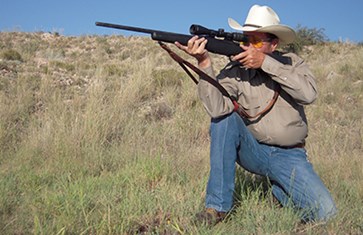 KNEELING:
KNEELING:
The kneeling position gives a much more solid platform from which to deliver that accurate shot. The strong-side knee goes to the ground. The support-side knee is bent with the foot pointed toward the target, planted as solidly as possible on the ground. A 90-degree angle between the legs helps make the position more solid and secure.
It is important that the bony tip of the elbow not be planted on top of the knee cap—bone-on-bone contact allows for too much movement. Placing the triceps, just above the elbow, on the knee, or the elbow into the thigh, will produce much steadier results. And that support arm should be as straight under the rifle’s fore-end as possible. This allows the shooter’s skeletal structure to support the weight of the rifle and reduces muscle fatigue.
From the kneeling position, the shooter still has good visibility and is in a much more solid position from which to deliver an accurate shot. By the same token, he can still get up and move fairly quickly should the situation require it.
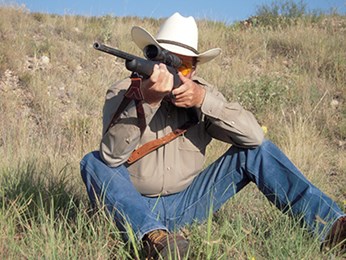 SITTING:
SITTING:
For most shooters the sitting position is an even steadier proposition. The shooter turns about 45 degrees away from the target as he or she sits on the ground. The feet should be spread as widely apart as possible and may be flat on the ground or resting on the heels, depending upon the shooter’s physical makeup. Both elbows are in front of the knee caps, with the triceps making actual contact.
An alternate position, again depending upon what is comfortable to the shooter, is to sit cross legged, pretzel style. The sides of the feet should be touching the ground.
While the sitting position can be quite steady, it is more difficult to get out of quickly. In addition, being lower to the ground, visibility may not be nearly as good. For this reason, it may not be the best position to use when after dangerous game because it takes much longer to adapt to the target’s movement.
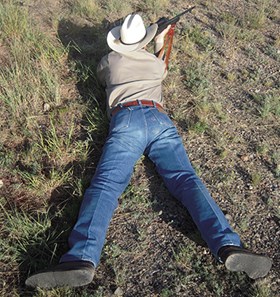 PRONE:
PRONE:
The prone position probably provides the most solid foundation of all. The shooter lies down with his legs spread apart with the toes pointed outward and the sides of the feet resting on the ground. With both elbows on the ground, they provide a bit of elevation adjustment. Spreading the elbows lowers the point of aim, and drawing them together raises it. Resting the fore-end of the rifle on a handy backpack also provides for a more solid rest.
While very accurate work can be done from the prone position, it has very limited use in the hunting field. The main problem is one of visibility as grass, other objects and the terrain itself may serve to obscure the target. And, of course, mobility is extremely limited.
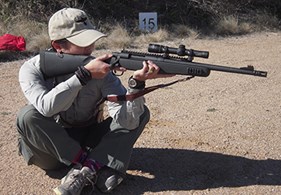 SLINGS:
SLINGS:
A word is also in order regarding the shooting sling. While the use of a sling is of questionable value when shooting from the standing position, it is very much worth using from kneeling, sitting or prone. Proper use of the sling locks the rifle into the body and enhances that solid foundation so critical to delivering an accurate shot.
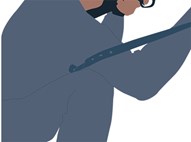 Rifle shooting is not a choreographed event unless, of course, you are a military trainee, and then it would be an excellent idea to use the exact positions that your drill instructor has so kindly shared with you. For the rest of us, we can safely modify the various positions to accommodate individual physiques and personal situations. We also note that in the hunting field the ground is usually never as smooth and level as that found on the practice range. These things require us to modify our positions to meet the needs of the situation. When modifying a particular shooting position it is important to keep in mind that it needs to be as comfortable as possible and as solid as possible. A satisfactory level of accuracy in our practice sessions will let us know that we are on the right track.
Rifle shooting is not a choreographed event unless, of course, you are a military trainee, and then it would be an excellent idea to use the exact positions that your drill instructor has so kindly shared with you. For the rest of us, we can safely modify the various positions to accommodate individual physiques and personal situations. We also note that in the hunting field the ground is usually never as smooth and level as that found on the practice range. These things require us to modify our positions to meet the needs of the situation. When modifying a particular shooting position it is important to keep in mind that it needs to be as comfortable as possible and as solid as possible. A satisfactory level of accuracy in our practice sessions will let us know that we are on the right track.
PRACTICE:
Needless to say, practice with these field positions is critically important. When the bull elk of your dreams steps out at 150 yds., it is not the time to be looking around you and trying to decide what field position to use and where to deploy it. Your eyes should always be on that magnificent target, and your body, from practice, should be getting into position to deliver that shot. This is definitely not the time to be looking at the ground, your sling or your rifle.
Once your rifle has been sighted in, it is time to get off the shooting bench and do all of your practice from field positions. Begin by standing with your rifle slung in your usual carry position. When you give yourself the command to go, your eyes should stay on the target while you wrap into your sling and assume a particular shooting position. The gun muzzle should already be pointed in the general direction of the target and you should exercise muzzle control at all times. It is even better to practice with a hunting buddy who can give you the command and time your ability to deliver that first shot. Your buddy can also point out any wasted movement or effort on your part, or even video it.
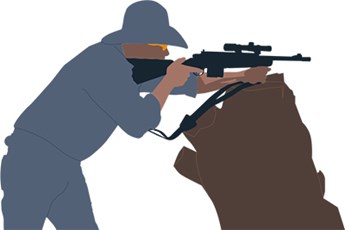 Of course, you can also practice acquiring the various positions right in your living room during dry-firing practice sessions. (You did unload the rifle, didn’t you? Well, please check it again just to be sure.) As with any other practice, work for smoothness and the ability to get locked in and ready without ever having to take your eyes off your target. Speed will come with practice.
Of course, you can also practice acquiring the various positions right in your living room during dry-firing practice sessions. (You did unload the rifle, didn’t you? Well, please check it again just to be sure.) As with any other practice, work for smoothness and the ability to get locked in and ready without ever having to take your eyes off your target. Speed will come with practice.
It is also a good idea to practice while wearing the actual coats and clothes that you plan to wear in the hunting field. Bulky clothes can affect one’s ability to assume a shooting position. And they may also require that the shooting sling be let out a notch or two.
Veteran hunters and those new to the game alike will benefit, as I did, from taking the No. 270 rifle class at Gunsite Academy (gunsite.com). The class focuses on developing solid field-shooting positions, using external rests, and working on stationary and moving targets. Gunsite also offers hunter-prep and safari-prep classes aimed at making the hunter as effective in the hunting field as possible. When you are serious about hunting, it is some of the best money that you can spend.
It is always reassuring and fun to shoot tight little groups from the shooting bench. It is difficult, however, to find a handy shooting bench when that mule deer buck blows out of that canyon header and starts to leave the country. Solid shooting positions and the fact that you have been practicing them is what will put that venison in your freezer and that trophy on your wall. Being a better field shot is part and parcel to becoming a better and more successful hunter.












